Input interpretation

acetone
Chemical names and formulas

formula | CH_3COCH_3 Hill formula | C_3H_6O name | acetone alternate names | 2-propanone | dimethylketal | dimethyl ketone | ketone, dimethyl- | ketone propane | methyl ketone | propan-2-one | propanone | pyroacetic ether mass fractions | C (carbon) 62% | H (hydrogen) 10.4% | O (oxygen) 27.5%
Lewis structure
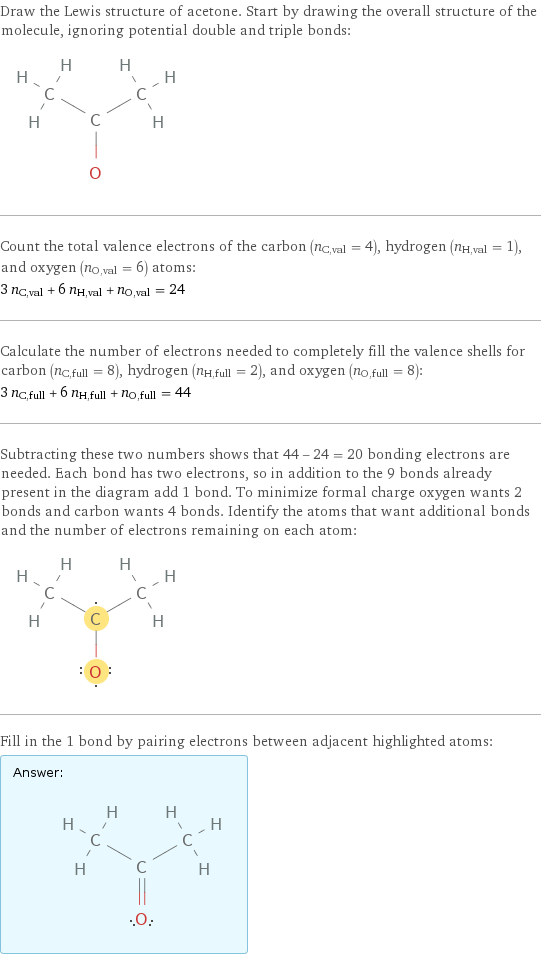
Draw the Lewis structure of acetone. Start by drawing the overall structure of the molecule, ignoring potential double and triple bonds: Count the total valence electrons of the carbon (n_C, val = 4), hydrogen (n_H, val = 1), and oxygen (n_O, val = 6) atoms: 3 n_C, val + 6 n_H, val + n_O, val = 24 Calculate the number of electrons needed to completely fill the valence shells for carbon (n_C, full = 8), hydrogen (n_H, full = 2), and oxygen (n_O, full = 8): 3 n_C, full + 6 n_H, full + n_O, full = 44 Subtracting these two numbers shows that 44 - 24 = 20 bonding electrons are needed. Each bond has two electrons, so in addition to the 9 bonds already present in the diagram add 1 bond. To minimize formal charge oxygen wants 2 bonds and carbon wants 4 bonds. Identify the atoms that want additional bonds and the number of electrons remaining on each atom: Fill in the 1 bond by pairing electrons between adjacent highlighted atoms: Answer: | |
3D structure

3D structure
Basic properties

molar mass | 58.08 g/mol phase | liquid (at STP) melting point | -94 °C boiling point | 56 °C (measured at 101308 Pa) density | 0.791 g/cm^3 solubility in water | miscible dielectric constant | 20.56
Liquid properties (at STP)
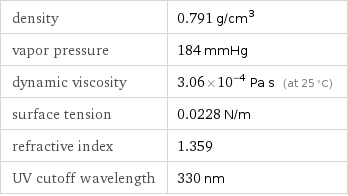
density | 0.791 g/cm^3 vapor pressure | 184 mmHg dynamic viscosity | 3.06×10^-4 Pa s (at 25 °C) surface tension | 0.0228 N/m refractive index | 1.359 UV cutoff wavelength | 330 nm
Units
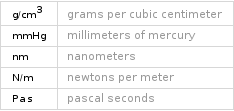
Thermodynamic properties

specific heat capacity c_p | gas | 1.283 J/(g K) | liquid | 2.175 J/(g K) molar heat capacity c_p | gas | 74.5 J/(mol K) | liquid | 126.3 J/(mol K) specific free energy of formation Δ_fG° | gas | -2.629 kJ/g molar free energy of formation Δ_fG° | gas | -152.7 kJ/mol specific heat of formation Δ_fH° | gas | -3.738 kJ/g molar heat of formation Δ_fH° | gas | -217.1 kJ/mol molar heat of vaporization | 31.9 kJ/mol | specific heat of vaporization | 0.549 kJ/g | molar heat of combustion | 1791 kJ/mol | specific heat of combustion | 30.84 kJ/g | molar heat of fusion | 5.77 kJ/mol | specific heat of fusion | 0.099 kJ/g | thermal conductivity | 0.1572 W/(m K) | critical temperature | 508 K | critical pressure | 4.72 MPa | (at STP)
Phase diagram
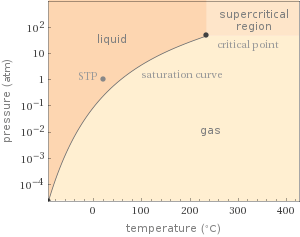
Phase diagram
Units

Chemical identifiers
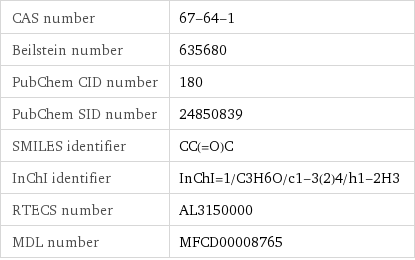
CAS number | 67-64-1 Beilstein number | 635680 PubChem CID number | 180 PubChem SID number | 24850839 SMILES identifier | CC(=O)C InChI identifier | InChI=1/C3H6O/c1-3(2)4/h1-2H3 RTECS number | AL3150000 MDL number | MFCD00008765